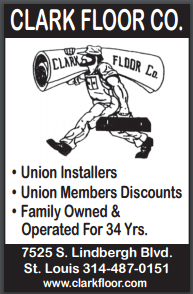
It’s the only one like it in America
By CARL GREEN
Correspondent
St. Louis – Starting a business is never easy, and in the construction field, it’s more difficult because of the many complications of getting projects done. It’s been even tougher for minority-owned companies trying to find a place in the local industry.
So the St. Louis construction industry and its unions are leading the way with an innovative project that can match minority and female business owners with good advice and support from experienced mentors in the industry.
It’s called the Regional Union Construction Center (RUCC), created in June 2006. Since then, it has quietly been getting the job done, helping to develop a growing roster of minority-owned companies that are becoming a stronger presence in the market. They are particularly important in completing government projects that require minority participation.
The program was a new idea and is the only one of its kind in the United States. It is also open to women.
Al Richter, a veteran local development official, has been executive director of the group since its founding, and he continues to play a hands-on role in fostering its client companies.
Richter uses his lengthy list of contacts in the industry to help each client company create an advisory board that provides advice, warnings and expertise as the clients grow and confront difficulties.
- An attorney who knows the construction business.
- A surety well versed in construction bonding.
- A CPA who knows construction accounting.
- An executive from another construction company.
- Richter himself, to keep everything on track.
“It isn’t easy to grow a company to start with, but when you have no skills, no contacts, no banking relationship, no resources, no marketing knowledge – it’s really tough,” Richter said.
ON BOARD
The board members work without charge, attend monthly meetings and communicate through phone calls and e-mails. Richter said he has always been able to find willing board members.
This group isn’t seen everywhere. It’s more about small victories and sustained momentum. Richter calls it “changing the paradigm.”
“This is a totally different concept, very costly but very intensive, and it does work,” he said. “Provided that you’ve got an owner with the ability to learn and grow and the desire to learn and grow. Those are two different things – ability and desire – but both are necessary.”
RUCC has wide support from local industry and unions, as seen in the content of its own board, which includes contractors, development agencies and labor unions.
 One board member, David Zimmermann, business manager of Sheet Metal Workers Local 36, said his union has been a supporter from the beginning.
One board member, David Zimmermann, business manager of Sheet Metal Workers Local 36, said his union has been a supporter from the beginning.
The St. Louis market hasn’t always been supportive to young companies, he noted. “It’s tough to get minority contractors because of how they are treated in the industry.” He singled out Ameren, Washington University, BJC Healthcare and Metropolitan Sewer District as strong supporters of minority contractors and the program.
“Al Richter does a tremendous job for us,” he added. “It’s a good program and we’re fully supportive. “
Another board member is Gary Elliott, business manager for the Eastern Missouri Laborers District Council. Elliott said he has been pleased by the program‘s effectiveness in helping craftsmen become businessmen.
“I think it’s a good format for contractors who start out but need some direction and some help,” he said. “It’s one thing to be a journeyman and another to be a businessman. That’s a big leap to go from one to another – it’s kind of like serving an apprenticeship.”
He noted that the service is free and covers difficult issues such as legal matters, bidding and establishing offices.
“They show the problems you can have, such as getting in over your head in bidding. It gets people to know the other side of the business,” he said.
The key is whether the business owner is fully committed to the program, he added. “They have to be 100 percent in,” he said.
RUCC arose out of discussions between three men involved with the diversity committee of the old PRIDE of St. Louis, Inc., itself a pioneering example of labor-management cooperation in construction. They were Terry Nelson, leader of the Carpenters District Council; Jim LaMantia, executive director of PRIDE at the time, and Bob McCoole, former president and CEO of Alberici Group.
They were concerned about how few minority contractors were able to build sustainable businesses from their initial contracts, saying the local industry has “failed miserably” at helping them succeed and taking his concerns to the PRIDE board, which appointed a steering committee and funding to create an incubator program.
Nelson wanted a new approach that might work better. LaMantia knew what Richter had been doing with the Small Business Development Center and gave him a call. With a 20-member task force including contractors, labor leaders and business professionals, RUCC was formed as a not-for-profit corporation with a 12-member board of directors.
It’s not a stretch to say Al Richter has been around for a while. He has worked in government positions, such as county executive in St. Clair County, Illinois, and was a corporate officer for United Van Lines. He owned his own mechanical contracting company for a time. Before working with RUCC, he spent eight years as regional director for the Small Business Development Center, and that was when he began working out the advisory board approach.
 “I’m way beyond retirement age, but this is almost a labor of love – trying to make a very small difference in terms of what’s going on,” he said. “What we’re trying to do here, it’s slow, it’s costly, it’s time-consuming, but I don’t know any other way to do it. You can’t throw it against the wall and hope it sticks. If we can get a bunch of successful people in their communities, that begets more success.
“I’m way beyond retirement age, but this is almost a labor of love – trying to make a very small difference in terms of what’s going on,” he said. “What we’re trying to do here, it’s slow, it’s costly, it’s time-consuming, but I don’t know any other way to do it. You can’t throw it against the wall and hope it sticks. If we can get a bunch of successful people in their communities, that begets more success.
ROOM FOR MORE
Richter’s current roster of six client companies includes three construction contractors, a flooring company, a fire protection provider and a plumbing firm.
“We’ve had some successes and some failures,” he said. “The landscape has changed immensely over the past 10-12 years. The real challenge is viable subcontractors. It’s easier to become a general contractor – you often don’t take the risk, you don’t do the detailed estimating, you don’t provide the tools and equipment. The subcontractors provide an awful lot of that.
“As a result, we have far more of a challenge meeting minority participation requirements with the people who perform the work. While we don’t exclude general contractors, all of the folks in our program to date have been specialty subcontractors.”
The program’s demands on its participants in working with their advisers are stern but are grounded in successful business practices.
“They’ve got to have their financials, they’ve got to have work in progress, they’ve got to have tables of receivables, they’ve got to have a marketing strategy, they’ve got to have an agenda,” Richter said. “We’ve got a crisp meeting, 60 to 90 minutes. It’s not a love-in. The whole purpose is to help them grow.”
He remains open to working with more local business owners or would-be owners.
“I’d love to see more,” he said. “One of our problems is getting the word out. A lot of folks in the industry know about us, but not enough. We’ve had great support, but there’s never enough.”
The Regional Union Construction Center can be contacted at (314) 725-5788 or through its website at ruccstl.org.



